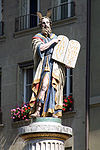
Mosesbrunnen
Encyclopedia

Münsterplatz
Münsterplatz is a German name for a plaza near a cathedral or .Münsterplätz can be found in the following cities:* Aachen* Basel, see Münsterplatz...
in the Old City of Bern, Switzerland
Switzerland
Switzerland name of one of the Swiss cantons. ; ; ; or ), in its full name the Swiss Confederation , is a federal republic consisting of 26 cantons, with Bern as the seat of the federal authorities. The country is situated in Western Europe,Or Central Europe depending on the definition....
. It is a Swiss Cultural Property of National Significance
Swiss Inventory of Cultural Property of National and Regional Significance
The Swiss Inventory of Cultural Property of National and Regional Significance is a register of some 8,300 items of cultural property in Switzerland...
and is part of the UNESCO
UNESCO
The United Nations Educational, Scientific and Cultural Organization is a specialized agency of the United Nations...
World Heritage Site
World Heritage Site
A UNESCO World Heritage Site is a place that is listed by the UNESCO as of special cultural or physical significance...
of the Old City of Bern.
History
The statue dates from 1544. After storm damage it was rebuilt in 1790-1791. The Louis XVI styleNeoclassicism
Neoclassicism is the name given to Western movements in the decorative and visual arts, literature, theatre, music, and architecture that draw inspiration from the "classical" art and culture of Ancient Greece or Ancient Rome...
basin was designed by Niklaus Sprüngli. The statue represents Moses bringing the Ten Commandments
Ten Commandments
The Ten Commandments, also known as the Decalogue , are a set of biblical principles relating to ethics and worship, which play a fundamental role in Judaism and most forms of Christianity. They include instructions to worship only God and to keep the Sabbath, and prohibitions against idolatry,...
to the Tribes of Israel. Moses is portrayed with two rays of light projecting from his head, which represent which tells that after meeting with God the skin of Moses' face became radiant. The twin rays of light come from a longstanding tradition that Moses instead grew horns
Horn (anatomy)
A horn is a pointed projection of the skin on the head of various animals, consisting of a covering of horn surrounding a core of living bone. True horns are found mainly among the ruminant artiodactyls, in the families Antilocapridae and Bovidae...
.
This is derived from a misinterpretation of the Hebrew phrase . The root
Triliteral
The roots of verbs and most nouns in the Semitic languages are characterized as a sequence of consonants or "radicals"...
(qoph
Qoph
Qoph or Qop is the nineteenth letter in many Semitic abjads, including Phoenician, Aramaic, Syriac, Hebrew and Arabic alphabet . Its sound value is an emphatic or . The OHED gives the letter Qoph a transliteration value of Q or a K and a final transliteration value as a ck...
, resh
Resh
Resh is the twentieth letter of many Semitic alphabets, including Phoenician, Aramaic, Hebrew and Arabic alphabet . Its sound value is one of a number of rhotic consonants: usually or , but also or in Hebrew....
, nun
Nun (letter)
Nun is the fourteenth letter of many Semitic abjads, including Phoenician, Aramaic, Hebrew and Arabic alphabet . It is the third letter in Thaana , pronounced as "noonu"...
) may be read as either "horn" or "ray of light
Halo (religious iconography)
A halo is a ring of light that surrounds a person in art. They have been used in the iconography of many religions to indicate holy or sacred figures, and have at various periods also been used in images of rulers or heroes...
", depending on vocalization. translates to "the skin of his face".
The correct interpretation of these two words is that Moses was enlightened, that "the skin of his face shone" (as with a gloriole
Halo (religious iconography)
A halo is a ring of light that surrounds a person in art. They have been used in the iconography of many religions to indicate holy or sacred figures, and have at various periods also been used in images of rulers or heroes...
), as the KJV has it.
The Septuagint correctly translates the Hebrew phrase as , "his face was glorified"; but Jerome
Jerome
Saint Jerome was a Roman Christian priest, confessor, theologian and historian, and who became a Doctor of the Church. He was the son of Eusebius, of the city of Stridon, which was on the border of Dalmatia and Pannonia...
translated the phrase into Latin
Latin
Latin is an Italic language originally spoken in Latium and Ancient Rome. It, along with most European languages, is a descendant of the ancient Proto-Indo-European language. Although it is considered a dead language, a number of scholars and members of the Christian clergy speak it fluently, and...
as cornuta esset facies sua "his face was horned".
With apparent Biblical authority, and the added convenience of giving Moses a unique and easily identifiable visual attribute
Emblem
An emblem is a pictorial image, abstract or representational, that epitomizes a concept — e.g., a moral truth, or an allegory — or that represents a person, such as a king or saint.-Distinction: emblem and symbol:...
(something the other Old Testament prophets notably lacked), it remained standard in Western art to depict Moses with small horns until well after the mistranslation was realized in the Renaissance
Renaissance
The Renaissance was a cultural movement that spanned roughly the 14th to the 17th century, beginning in Italy in the Late Middle Ages and later spreading to the rest of Europe. The term is also used more loosely to refer to the historical era, but since the changes of the Renaissance were not...
. In this depiction of Moses, the error has been identified but the artist has chosen to place horns of light on Moses head to aid in identification.

